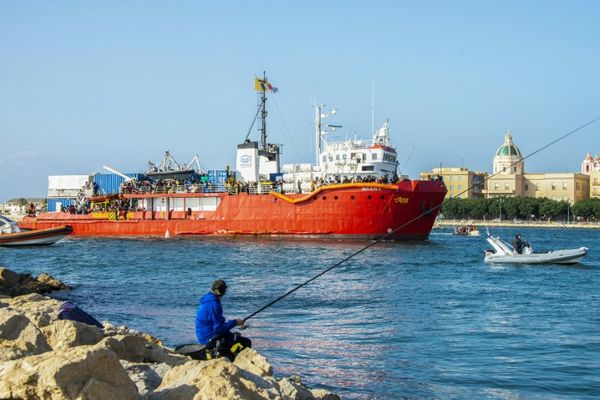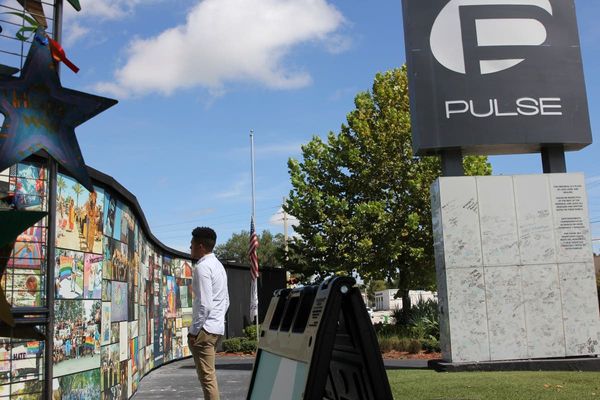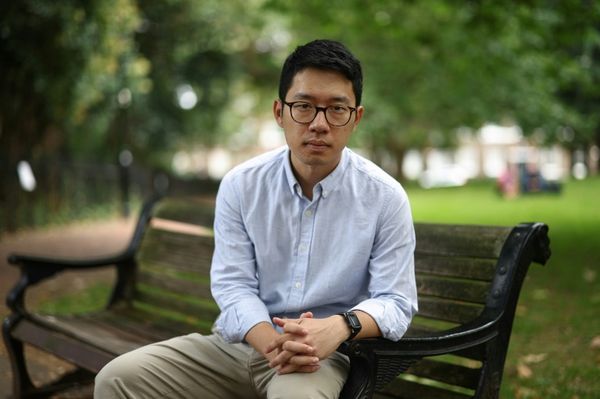
By night, the Hong Kong skyline is one giant electric rainbow, a riot of twinkling, swirling lights. Some of its towers carry pixellated messages across their facades. Others throb with the logos of businesses and banks. But one illuminated sign now stands out from the rest. This big rectangle operates on an entirely different frequency. One minute, it pulses with animated op-art patterns. The next, it delivers a slideshow of mid-century furniture and architectural models. Then it erupts with a cloud of pink cherry blossom against a bright blue sky, creating a surreal backdrop to the ferries crossing the harbour.
“It’s like a pirate ship,” says Jacques Herzog, one half of Herzog & de Meuron, the Swiss architects behind this 20-storey-high building cum billboard, “sailing into the commercial landscape of Hong Kong with an artistic message.”
The supersized screen signals the presence of M+, billed as “Asia’s first global museum of visual culture”, which tentatively opened its doors in November 2021 during the Covid pandemic, making any review of it tricky at the time. Two years on, despite all the travel restrictions during lockdown, it has received more than 5 million visitors, making it one of the most popular art museums in Asia.
Its name stands for “Museum and more” – but more of what exactly? Heft, for one. Up close, M+ is less plucky pirate ship, more colossal tanker. It contains more than double the exhibition space of London’s Tate Modern, mostly laid out on one single, gargantuan floor. This vast array of galleries is jacked up over the West Kowloon waterfront, with public decks above and below it where visitors gather, as on the deck of a liner, to gawp at the mesmerising panorama of Victoria Harbour.

The rectangular billboard rises above, with members’ lounge and restaurant concealed inside, along with some floors leased to local universities. It stands on an elevated podium, making the whole building look more like a postwar corporate HQ than a public attraction. But the architectural reticence seems intentional. While mainland China’s museum boom over the last two decades spawned ever more contorted icons of blobitecture, M+ wants you to know it has no need for such a garish home. This is a global powerhouse of art, keen to be judged alongside MoMA, Tate and the Pompidou, disguised as a nondescript office block. “It’s a Trojan horse,” says Herzog. And perhaps a seemingly innocuous container is just what is needed, given how the museum must navigate the censorship regime.
It may look like a demure box from afar, but the building reveals special qualities as you get closer. The dull grey grille of the facade turns out to be made up of glossy ceramic fins, glazed a deep green, echoing traditional Chinese roof tiles and canes of bamboo. It shimmers like corduroy, forming a chameleonic coat that can be silver, green, black or gold depending on the time of day, before unveiling its neon costume by night. More than 5,000 LED tubes are embedded in the horizontal ceramic fins, cleverly calibrated with two focal lengths so that the nightly show of commissioned video works and ads for the M+ collection is legible from both near and far.
Entering from any side, beneath the deep overhanging podium, visitors arrive in a big open lobby where slices in the ceiling and floor provide vertiginous views. Look up and you see the tower rising above the galleries, while diagonal cuts in the floor reveal a precipitous drop into a subterranean concrete world below – where a sign points momentously to the “Found Space”.

It’s a curious conceit. The competition brief for the building, drawn up in 2012, specified that, along with the usual kind of white cube galleries, reconfigurable spaces and screening rooms, the museum wanted an “industrial space” akin to Tate’s oil tanks or Shanghai’s power station of art. The only problem being, this was not a repurposed relic of industry, but a museum built from scratch on a virgin piece of reclaimed land.
Herzog & de Meuron decided to dig, taking an “archeological” approach, unearthing an unlikely gift in the form of the Airport Express train tunnel, cutting diagonally beneath the site. “It was like discovering the body of a huge animal,” says Herzog. “It gave us the impulse to create a kind of underworld, which is mysterious and strange – and so Hong Kong.”
Although he makes it sound seductive – a raw chunk of urban infrastructure slicing through the museum – the reality does not make for a particularly compelling or useful space. It is an awkward, triangular concrete well, 30 metres from floor to ceiling, with the inaccessible concrete shell of the tunnel cutting across one side, encased in an extra layer of concrete, surrounded by immense concrete columns holding up the criss-crossing concrete floors above. It feels highly manufactured, lacking the character of a truly found space. You don’t even hear any rumbles from the train, so thick is the masonry tomb.
The architects describe it as “a space of unprecedented potential”, and it has so far staged some dangling installations. But it was empty on my visit, and curators confide that they struggle to find ways to use it. As for the carbon footprint, HdM says concrete was the only viable option, given groundwater levels, typhoon requirements, fire risk and longevity. But Herzog admits “the discussion was different 10 years ago”, and this is likely one of their last projects to fetishise concrete to quite such an extent.
Upstairs, the main galleries are more successful, forming a well-paced sequence with light filtering in from various directions and plenty of views out to the harbour, helping to avoid museum fatigue. There is a tall, cell-like concrete gallery – a fitting prison for Paul Chan’s convulsing inflatable figures, currently on show – and a warm wooden drawings gallery, while the bamboo-lined corridor to the loos is an unexpected influencer magnet. A variety of stepped areas, indoors and out, provide ample opportunities for more posing: M+ has become Hong Kong’s wedding photo spot du jour.
The rooftop garden is a treat too, if you can find the way there. It should be easy. A sculptural white spiral staircase beckons you upwards from the galleries, in a classic HdM flourish, flanked by the zig-zagging struts of gigantic concrete trusses. But it is roped off. It was supposed to lead to a cafe and out to the roof garden, but the unit is now occupied by an exclusive Korean restaurant run by a Michelin-starred chef, not a place for hoi polloi to be seen traipsing through. To reach the roof garden, a gallery assistant advises bemused visitors to get the elevator back down to the entrance level, switch elevators, and come back up.

In fact, trying to get to the museum in the first place is similarly challenging. The nearest metro station is across a bridge, up and down several escalators, in the bowels of a shopping mall whose operators clearly prefer people to get lost in their retail labyrinth rather than find their way to the museum. Once you emerge, you are greeted with the blank concrete silo of M+’s conservation and storage building, a later addition to the brief whose lower floors are leased to the Phillips auction house, so it is their gigantic logo you see first, not the museum’s.
The nearest bus stop, meanwhile, drops you on the edge of an eight-lane highway from where you must tackle a 20-minute obstacle course of bridges and underpasses. Finally, coming by car (which, strangely for such a public transport-oriented city, was the recommended option) leaves you in an unprepossessing undercroft, as if you’re coming to service the boiler. Even arriving on foot presents challenges: the building is so big and “permeable”, with entrances on all sides, that the museum cannot staff all its doors, so many remain locked. A dedicated ferry service, opening later this year, should hopefully provide a more seamless arrival.
Some of the hiccups may be explained by the project’s tortured gestation. M+ is one of the star attractions of the West Kowloon Cultural District (WKCD). Stretching across 40 hectares of reclaimed land, the vision for this HK$21.6bn (£2.2bn) megaproject was first tabled after the handover of Hong Kong in 1997, following a survey by the tourism board that concluded the territory needed more cultural attractions to lure visitors.
Norman Foster won the masterplan competition in 2002, with a scheme for a huge glass canopy covering most of the site (echoing Richard Rogers’ similarly bonkers 1994 plan for London’s Southbank). Following intense public criticism over the cost and lack of consultation, it was scrapped. Foster went on to win again in 2011, this time with a plan for a large “art park” flanked by a dense strip of 17 cultural venues. The cross-section depicted a thrilling Blade Runner-esque sandwich of auditoria stacked above layers of roads and railway lines, with “a rich mixture of colonnades, alleyways, lanes and tree-lined promenades” that promised to have all the bustle of Hong Kong’s liveliest streets.
So far, little of this is evident. The art park, designed by Dutch landscape firm West 8, opened in 2019 and has become a popular spot for picnics and evening strolls – as one of the few public spaces in Hong Kong where dogs are allowed. The rest of the area is still mostly a building site, but what is emerging looks less like the promised dense urban quarter and more like a motley hotchpotch of architectural misfits, marooned on the waterfront.

At the eastern end stands the Xiqu Centre, a Chinese opera house designed by Canadian practice Revery, along with local architect Ronald Lu, as a lumpen box wrapped in a swirly metallic curtain. To the west is the Hong Kong Palace Museum – introduced later as a political sop to Beijing – a repository of dazzling artefacts from the Forbidden City, housed in an angular golden container adorned with imperial motifs, by local firm Rocco Design Architects.
Rising next to M+ is the hefty concrete frame of the Lyric theatre, by Dutch firm UN Studio in their trademark sinuous style, to be wrapped in bronzed cladding like a tacky executive toy. Other objects lie scattered around the park, including the big grey shoebox of the Freespace performance venue, by local architects Dennis Lau & Ng Chun Man, and various railway tunnel ventilation buildings, jaunty relics from the late postmodern era designed by Terry Farrell and RMJM. None of it really appears to have been planned.
It might be unfair to judge a work in progress, but the overall vision seems recklessly naive; a desperate attempt to compete with mainland China’s cultural building boom. Besides the vast venues already completed or under construction, there are plots earmarked for another Music Centre, a Great Theatre, a Musical Theatre and a Medium Theatre. In August last year, WKCD chairman Henry Tang Ying-yen warned that the organisation must “think out of the box”, suggesting that it might need to shift towards more residential and commercial developments – or risk running out of money by 2025.
Yet there are questions over the appetite for such private investments in a weakened property market. Income from offices and hotels was supposed to cover the operating costs of M+ and its neighbours, but the first tender for a group of commercial towers was cancelled after lack of interest. It was relaunched with more favourable terms, and awarded in 2022 to Winner Harvest (the only company that tendered for the project) which plans to hem the museum and theatre in with generic glass blocks.
Operational flaws aside, M+ is tough enough to thrive, whatever emerges around it. But it is hard not to think that the urge to build colossal cultural districts from scratch, the size of multiple Southbanks, belongs to a bygone era.







